For purposes of demonstration, we will assume you have purchased one of our “dish garden kits”. Of course, you can easily collect all of you own material. Note: Our ‘dish garden kits’ are not currently available on our online catalog. This is presented for instructional purposes.
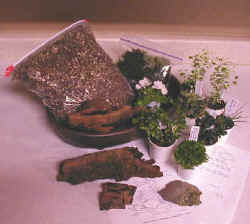
DISH GARDEN KIT
Included in the kit will be:
1 Plastic bonsai tray
Some rock and/or wood
1 Bag of potting soil
8 Plants for small dish garden (16 for large kit)
Field moss or small bark for potting mix cover
(moss can only be collected and shipped in season)
Detailed instructions and landscape plan
Unpack you plant material as soon as possible. Check to see if anything needs to be watered. Dampen potting mix with 1 cup hot water for small kit (2 cups for large kit). Let moistened soil stand overnight.
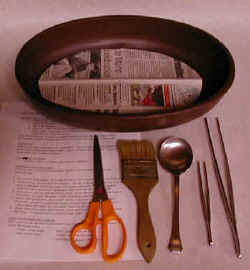
Tools that will be helpful:
Scissors–to trim plant material
Brush–for cleaning
Spoon–for adding, tamping soil
Tweezers–for handling plants
Plant mister or sprayer–to water
Constructing your dish garden:
A dish garden is a miniature landscape. Refer to the enclosed sketches and landsape plan for ideas.
Step 1. Cut a piece of newspaper to fit the bottom of the bonsai tray and line the tray bottom. This will keep the soil from falling through the drainage holes. Eventually, the paper will decompose but, by then, the plants will be rooted and able to hold the soil
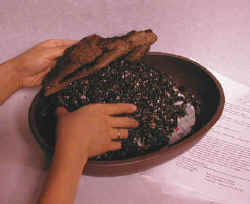
Step 2. Fill about half the tray with potting mix. Use one or two (two or three for large kit) flat pieces of rock or wood in the back to provide support for the higher soil level.
Mound soil against the rocks or wood to create a sense of topography–try to avoid creating a flat, two-dimensional, landscape. Add more soil until tray is filled.
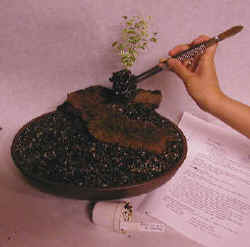
Step 3. Use rocks or wood to add a decorative touch. Prepare a landscape and make sure that soil is firm, so that when plants are added the soil won’t sink.
Remove plants from original pots and gently shake off excess soil from around root system. If plant is already pot-bound, you may trim away some of the root-ball to control the plant’s growth–remember, you want to create a miniature landscape. Use tweezers to create holes, then place plants into them.
If you’re a bit messy doing this, don’t worry. You can always clean this up later.
Hint: It’s best to use plants when they are not overly wet or dry. Here’s our rule of thumb–if they are to be watered tomorrow, use them today. Plants will be easier to handle and less messy.
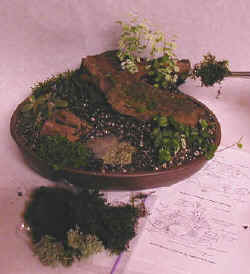
Step 4. Use smaller rocks or wood to add a decorative touch.
Plant all material except for African violet (to avoid damaging it, this will be done last). Cover bare spots with field moss or small bark.
Push moss down into soil using tweezers. Be sure it has good attachment to the soil. If it appears too loose, use “U” pins (or one end of a paper clip) to pin moss firmly into soil.
Hint: To lend interest to the planting, try to avoid using similar colors all in the same spot. Usually, the “bush-type” and “ground-cover” plants that we ship have three cuttings per pot. You may plant each cutting separately.
Another hint: Grasses look best when planted in the small spaces between rocks and/or wood.
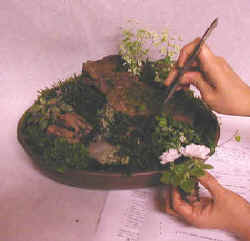
Step 5. Remove violet from its pot, shaking loose excess soil. If plant is too large for the area you plan to use it, you can remove some of the lower (oldest) leaves.
Use tweezers to create a hole where you plan to place the violet. The size of the hole should be just barely the size of the violet’s root-ball.
Using tweezers to hold the root-ball of the violet, firmly insert it into the hole. Try not to use your fingers–tweezers are much better suited for this job. Gently brush away any unwanted soil from the container.
Hint: We always ship miniature African violets, usually in colors of blue, white, or pink (not “unnatural” multicolors). Of course, you may choose other miniature plants, such as sinningia, for example.
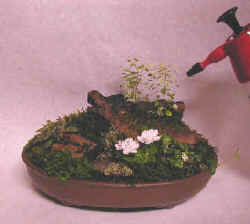
Step 6. Water individual plants, using a plant mister or sprayer. Water the base of plants, avoiding misting of the violet flowers.
Place your garden in a location with bright, diffused, sunlight–bright light, but not hot sun! Even better, place it beneath artificial lights like a two-tube florescent shop light. Place about 12″ below lights for 13 hours a day.
Water when dry, using mister or sprayer. To keep moss and other shallow-rooted plants looking fresh, a daily misting is much recommended, particularly if humidity is low or temperatures are high. A more thorough watering can be done when plants need it.
Fertilize your plants every time you water with a balanced formula, and trim overgrown plants once a month to keep them “in shape”.
Good luck! Once you’ve acquired and prepared all of the necessary materi
